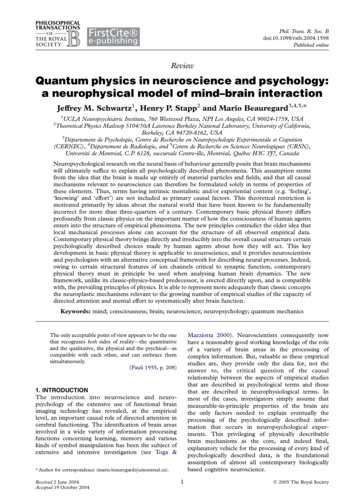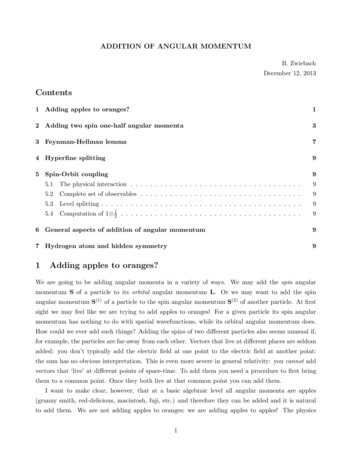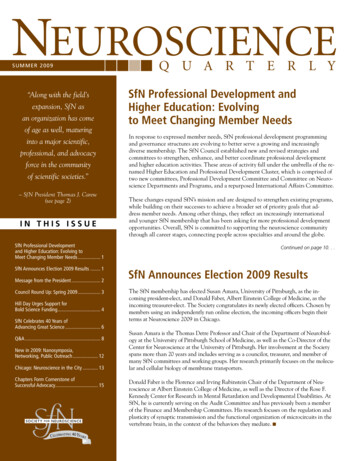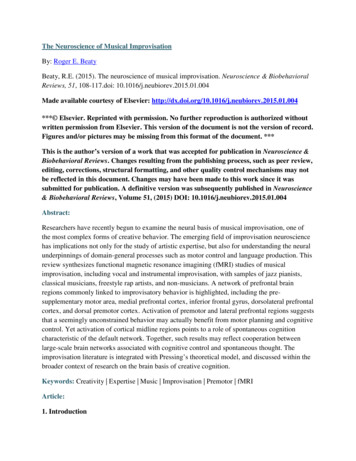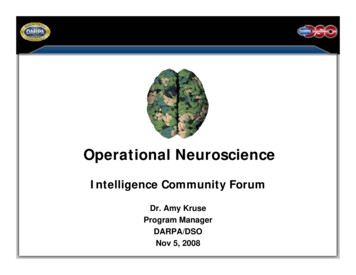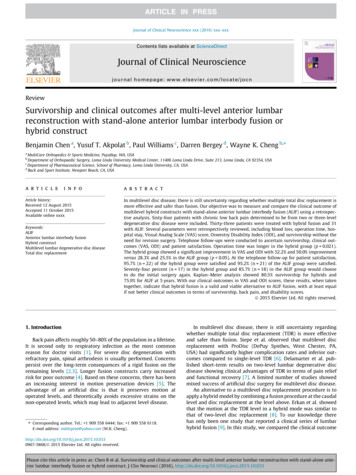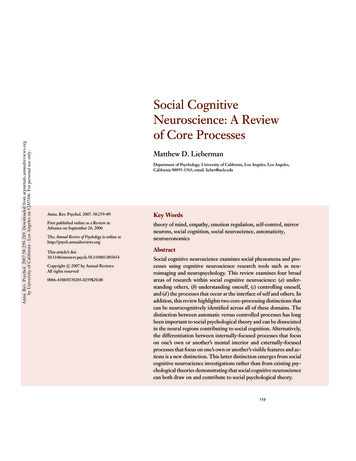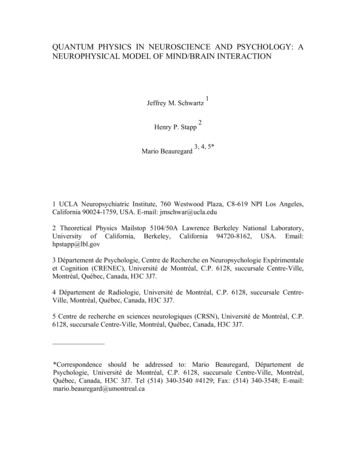
Transcription
QUANTUM PHYSICS IN NEUROSCIENCE AND PSYCHOLOGY: ANEUROPHYSICAL MODEL OF MIND/BRAIN INTERACTIONJeffrey M. SchwartzHenry P. StappMario Beauregard123, 4, 5*1 UCLA Neuropsychiatric Institute, 760 Westwood Plaza, C8-619 NPI Los Angeles,California 90024-1759, USA. E-mail: jmschwar@ucla.edu2 Theoretical Physics Mailstop 5104/50A Lawrence Berkeley National Laboratory,University of California, Berkeley, California 94720-8162, USA. Email:hpstapp@lbl.gov3 Département de Psychologie, Centre de Recherche en Neuropsychologie Expérimentaleet Cognition (CRENEC), Université de Montréal, C.P. 6128, succursale Centre-Ville,Montréal, Québec, Canada, H3C 3J7.4 Département de Radiologie, Université de Montréal, C.P. 6128, succursale CentreVille, Montréal, Québec, Canada, H3C 3J7.5 Centre de recherche en sciences neurologiques (CRSN), Université de Montréal, C.P.6128, succursale Centre-Ville, Montréal, Québec, Canada, H3C 3J7.*Correspondence should be addressed to: Mario Beauregard, Département dePsychologie, Université de Montréal, C.P. 6128, succursale Centre-Ville, Montréal,Québec, Canada, H3C 3J7. Tel (514) 340-3540 #4129; Fax: (514) 340-3548; E-mail:mario.beauregard@umontreal.ca
ABSTRACTNeuropsychological research on the neural basis of behavior generally posits that brainmechanisms will ultimately suffice to explain all psychologically described phenomena.This assumption stems from the idea that the brain is made up entirely of materialparticles and fields, and that all causal mechanisms relevant to neuroscience can thereforebe formulated solely in terms of properties of these elements. Thus terms having intrinsicmentalistic and/or experiential content (e.g., "feeling," "knowing," and "effort") are notincluded as primary causal factors. This theoretical restriction is motivated primarily byideas about the natural world that have been known to be fundamentally incorrect formore than three quarters of a century. Contemporary basic physical theory differsprofoundly from its seventeenth to nineteenth century forebearers on the important matterof how the consciousness of human agents enters into the structure of empiricalphenomena. The new principles contradict the older idea that local mechanical processesalone can account for the structure of all observed empirical data. Contemporary physicaltheory brings directly and irreducibly into the overall causal structure certainpsychologically described choices made by human agents about how they will act. Thiskey development in basic physical theory is applicable to neuroscience, and it providesneuroscientists and psychologists with an alternative conceptual framework fordescribing neural processes. Indeed, due to certain structural features of ion channelscritical to synaptic function, contemporary physical theory must in principle be usedwhen analyzing human brain dynamics. The new framework, unlike its classical-physicsbased predecessor is erected directly upon, and is compatible with, the prevailingprinciples of physics, and is able to represent more adequately than classical concepts the2
neuroplastic mechanisms relevant to the growing number of empirical studies of thecapacity of directed attention and mental effort to systematically alter brain function."[T]he only acceptable point of view appears to be the one that recognizes both sides ofreality --- the quantitative and the qualitative, the physical and the psychical --- ascompatible with each other, and can embrace them simultaneously."Wolfgang Pauli, The Influence of Archetypal Ideas on the Scientific Theories of Kepler1. IntroductionThe introduction into neuroscience and neuropsychology of the extensive use offunctional brain imaging technology has revealed, at the empirical level, an importantcausal role of directed attention in cerebral functioning. The identification of brain areasinvolvedina inglearning, memory and various kinds of symbol manipulation has been the subjectof extensive and intensive investigation (See Toga & Mazziotta 2000). Neuroscientistsconsequently now have a reasonably good working knowledge of the role of a variety ofbrain areas in the processing of complex information. But, valuable as these empiricalstudies are, they provide only the data for, not the answer to, the critical question of thecausal relationship between the aspects of empirical studies that are described inpsychological terms and those that are described in neurophysiological terms. In the vast3
majority of cases investigators simply assume that measurable-in-principle properties ofthe brain are the only factors needed to explain eventually the processing of thepsychologically described information that occurs in neuro-psychological experimentsThis privileging of physically describable brain mechanisms as the core, and indeedfinal, explanatory vehicle for the processing of every kind of psychologically describeddata is the foundational assumption of almost all contemporary biologically basedcognitive neuroscience.It is becoming increasingly clear, however, that there is at least one type of informationprocessing and manipulation that does not readily lend itself to explanations that assumethat all final causes are subsumed within brain, or more generally, central nervous system(CNS) mechanisms. The cases in question are those in which the conscious actof willfully altering the mode by which experiential information is processed itselfchanges, in systematic ways, the cerebral mechanisms utilized. There is a growingrecognition of the theoretical importance of applying experimental paradigms thatemploy directed mental effort in order to produce systematic and predictable changes inbrain function (e.g., Beauregard et al. 2001; Ochsner et al. 2002). These willfullyinduced brain changes are generally accomplished through training in, and the applieduse, of cognitive reattribution and the attentional re-contextualization of consciousexperience. Furthermore, an accelerating number of studies in the neuroimaging literaturesignificantly support the thesis that, again, with appropriate training and effort, peoplecan systematically alter neural circuitry associated with a variety of mental and physicalstates that are frankly pathological (Schwartz et al. 1996; Schwartz 1998; Musso et al.4
1999; Paquette et al. 2003). A recent review of this and the related neurological literaturehas coined the term "self-directed neuroplasticity" to serve as a general description ofthe principle that focused training and effort can systematically alter cerebral function ina predictable and potentially therapeutic manner (Schwartz & Begley 2002).From a theoretical perspective perhaps the most important aspect of this line of researchis the empirical support it provides for a new science-based way of conceptualizing theinterface between mind/consciousness and brain. Until recently virtually all attempts tounderstand the functional activity of the brain have been based at least implicitly on someprinciples of classical physics that have been known to be fundamentally false for threequarters of a century. According to the classical conception of the world, allcausal connections between observables are explainable in terms of mechanicalinteractions between material realities. But this restriction on modes of causation isnot fully maintained by the currently applied principles of physics, which consequentlyoffer an alternative conceptual foundation for the scientific description and modeling ofthe causal structure of self-directed neuroplasticity.The advantages for neuroscience and neuropsychology of utilizing the conceptualframework of contemporary physics, as opposed to that of classical physics, stemfrom five basic facts. First, terms such as "feeling," "knowing" and "effort," because theyare intrinsically mentalistic and experiential, cannot be described exclusively in terms ofmaterial structure. Second, in order to explain the observable properties of large physicalsystems that depend sensitively upon the behaviors of their atomic constituents the5
founders of contemporary physical theory were led to introduce explicitly into the basiccausal structure of physics certain important choices made by human beings about howthey will act. Third, within this altered conceptual framework these choices are describedin mentalistic (i.e., psychological) language. Fourth, terminology of precisely this kindis critically necessary for the design and execution of the experiments in which the datademonstrating the core phenomena of self-directed neuroplasticity are acquired anddescribed. Fifth, the injection of psychologically described choices on the part of humanagents into the causal theoretical structure can be achieved for experiments inneuroscience by applying the same mathematical rules that were developed to account forthe structure of phenomena in the realm of atomic science.The consequence of these facts is that twentieth century physics, in contrast to itsseventeenth to nineteenth century forebearers, provides a rationally coherent pragmaticframework in which the psychologically and neurophysically described aspects of theneuroscience experiments mentioned above are causally related to each other inmathematically specified ways. Thus contemporary physics allows the data fromthe rapidly emerging field of self-directed neuroplasticity to be described and understoodin a way that is more rationally coherent, scientific, and useful than what is permitted bytheories in which all causation is required to be fundamentally mechanical.To explicate the physics of the interface between mind/consciousness and the physicalbrain, we shall in this article describe in detail how the quantum mechanically basedcausal mechanisms work, and show why it is necessary in principle to advance to the6
quantum level to achieve an adequate theory of the neurophysiology of volitionallydirected activity. The reason, basically, is that classical physics is an approximation to themore accurate quantum theory, and that this classical approximation eliminates the causalefficacy of our conscious efforts that these experiments empirically manifest.It will also be explained how certain structural features of ion conductance channelscritical to synaptic function entail that the classical approximation fails in principle tocover the dynamics of a human brain. Quantum dynamics must be used in principle.Furthermore, once the transition to the quantum description is made, the principles ofquantum theory must, in order to maintain rational consistency and coherency, be used tolink the quantum physical description of the subject’s brain to his stream of consciousexperiences. The conscious choices by human agents thereby become injectednontrivially into the causal interpretation of neuroscience and neuropsychologyexperiments. This caveat particularly applies to those experimental paradigms in whichhuman subjects are required to perform decision-making or attention-focusing tasks thatrequire conscious effort.2. Practical ramifications of the altered conception of the causal structure ofself-directed neuroplasticityClarity is required about the sorts of neuroscientific reasoning that remain coherent,given the structure of modern physics, and, contrastingly, the types of assertions that cannow be viewed as the residue of a materialistic bias stemming from a superceded physics7
Entirely acceptable are correlational analyses concerning the relationship betweenmentalistic data and neurophysiological mechanisms. Examining the qualitativeand quantitative aspects of brain function, and doing detailed analyses of how they relateto the data of experience, obtained through increasingly sophisticated means ofpsychological investigation and subject self-report analysis (e.g., the entire Sep/Oct 2003issue of Journal of Consciousness Studies, Volume 10, Number 9-10, is dedicated tothese questions), are completely in line with fundamental physics. These activities are thecore of neuropsychological science. What is not justified is the presumption, either tacitor explicit, that all aspects of experience examined and reported are necessarily causalconsequences solely of brain mechanisms. The structure of contemporary physics entailsno such conclusion. This is particularly relevant to data from first person reportsconcerning active willfully directed attentional focus, and especially to data pertainingto which aspects of the stream of conscious awareness a subject chooses to focus onwhen making self-directed efforts to modify and/or modulate the quality and beam ofattention. In such cases the structure of orthodox quantum physics implies that theinvestigator is not justified in assuming that the focus of attention is determined whollybybrain ndmechanically determined. Conscious effort itself can, justifiably within science, be takento be a primary variable whose complete causal origins may be untraceable in principle,but whose causal efficacy in the physical world can be explained on the basis of the lawsof physics.8
As already emphasized, the cognitive frame in which neuroscience research, includingresearch on cerebral aspects of behavior, is generally conducted contains within it theassumption that brain mechanisms are in principle fully sufficient to explain all ofthe observed phenomena. In the fields of functional neuroimaging this has led toexperimental paradigms that focus primarily on changes in brain tissue activation asprimary variables used to explain whatever behavioral changes are observed --- includingones understood as involving essentially cognitive and emotional responses. As long asone is investigating phenomena that are mostly passive in nature this may be fullyjustified. A person is shown a picture depicting an emotionally or perhaps a sexuallyarousing scene. The relevant limbic and/or diencephalic structures are activated. Theinvestigator generally concludes that the observed brain activation has some intrinsiccausal role in the emotional changes reported (or perhaps, the hormonal correlates ofthose changes).All is well and good, as far as it goes. And all quite passive from the experimentalsubject's perspective --- all that's really required on his or her part is to remainreasonably awake and alert, or, more precisely, at least somewhat responsive to sensoryinputs. But when, as happens in a growing number of studies, the subject makes anactive response aimed at systematically altering the nature of the emotional reaction --for example, by actively performing a cognitive reattribution --- then the demand that thedata be understood solely from the perspective of brain-based causal mechanism is asevere and counter-intuitive constraint. It is noteworthy that this demand for an entirely9
brain-based causal mechanism it is nullified, in the quantum model developed here, by aspecified quantum effect, which will be described in detail below.Surmounting the limitations imposed by restricting ones ideas to the failed concepts ofclassical physics can be especially important when one is investigating how to developimproved methods for altering the emotional and cerebral responses to significantlystressful external or internally generated stimuli. An incorrect assignment of the causalroles of neurophysiologically and mentalistically described variables can impactnegatively on a therapist's selection of a course of treatment, on a patient's capacity torecover, and on a neuroscientist's design of clinically relevant research programs.In the analysis and development of clinical practices involving psychologicaltreatments and their biological effects the possession and use of a rationally coherent andphysically allowable conception of the causal relationship between mind and brain (or, ifone prefers, mentalistic and neurophysiological variables) is critical. If one simplyaccepts the standard presumption that all aspects of emotional response arepassively determined by neurobiological mechanisms, then the theoretical developmentof genuinely effective self-directed psychological strategies that produce realneurobiological changes can be blocked by the fact that one is using a theory thatexcludes from the dynamics what logically can be, and in our model actually are,key causal elements, namely our willful choices.10
The clinician's attention is thus directed away from what can be in many cases, at thelevel of actual practice, a powerful determinant of action, namely the subject'spsychologically (i.e., mentalistically) framed commitment to act or think in specificways. The therapist tends to becomes locked into the view that the psychologicaltreatment of ailments caused by neurobiological impairments is not a realistic goal.There is already a wealth of data arguing against this view. For instance, work in the1990's on patients with obsessive compulsive disorder demonstrated significant changesincaudatenucleusmetabolism andorbitofrontal tientsrelationshipswhoofrespondedthetoa psychological treatment utilizing cognitive reframing and attentional refocusing as keyaspects of the therapeutic intervention (for review see Schwartz & Begley 2002). Morerecently work by Beauregard and colleagues (Paquette et al. 2003) have demonstratedsystematic changes in the dorsolateral prefrontal cortex and parahippocampal gyrusafter cognitive-behavioral therapy for spider phobia, with brain changes significantlyrelated to both objective measurements and subjective reports of fear and aversion. Thereare now numerous reports on the effects of self-directed regulation of emotionalresponse, via cognitive reframing and attentional re-contextualization mechanisms, oncerebral function (e.g., Beauregard et al. 2001; Lévesque et al. 2003; Ochsner et al. 2002;Paquette et al. 2003; Schwartz et al. 1996).The brain area generally activated in all the studies done so far on the self-directedregulation of emotional response is the prefrontal cortex, an area of the brain also11
activated in studies of cerebral correlates of willful mental activity, particularly thoseinvestigating self-initiated action and the act of attending to one's own actions (Spence &Frith 1999; Schwartz & Begley 2002). There is however one aspect of willful mentalactivity that seems particularly critical to emotional self-regulation and that seems to bethe critical factor in it's effective application --- the factor of focused dispassionate selfobservation that, in a rapidly growing number of clinical psychology studies, has come tobe called mindfulness or mindful awareness (Segal et al. 2002)The mental act of clear-minded introspection and observation, variously known asmindfulness, mindful awareness, bare attention, the impartial spectator, etc. is a welldescribed psychological phenomenon with a long and distinguished history in thedescription of human mental states (Nyanaponika 2000). The most systematic andextensive exposition is in the canonical texts of classical Buddhism preserved in thePali language, a dialect of Sanskrit. Because of the critical importance of this type ofclose attentiveness in the practice of Buddhist meditation, some of it's most refineddescriptions in English are in texts concerned with meditative practice (although it is ofcritical importance to realize that the mindful mental state does not require anyspecific meditative practice to acquire, and is certainly not in any sense a "trance-like"state).One particularly well-established description, using the name bare attention, is asfollows:12
"Bare Attention is the clear and single-minded awareness of what actually happens to usand in us at the successive moments of perception. It is called 'Bare' because it attendsjust to the bare facts of a perception as presented either through the five physical sensesor through the mind . . . without reacting to them." (Nyanaponika 1973, p.30)Perhaps the essential characteristic of mindful observation is that you are just watching,observing all facts, both inner and outer, very calmly, clearly, and closely. To sustain thisattentional perspective over time, especially during stressful events, invariably requiresthe conscious application of effort.A working hypothesis for ongoing investigation in human neurophysiology, based on asignificant body of preliminary data, is that the mental action of mindful awarenessspecifically modulates the activity of the prefrontal cortex. Because of the wellestablished role of this cortical area in the planning and willful selection of self-initiatedresponses (Spence & Frith 1999; Schwartz & Begley 2002), the capacity of mindfulawareness, and by implication all emotional self-regulating strategies, to specificallymodulate activity in this critical brain region has tremendous implications for the fieldsof mental health and related areas.It might be claimed that the designs and executions of successful clinical practices (andof informative neuropsychological experiments) that depend on the idea of the causalefficacy of conscious effort, and which fit so well into the quantum conceptualization thatactually explains the causal efficacy of these efforts, could just as well be carried out13
within the conceptual framework in which the causal efficacy of willfull effort is anillusion, or is something very different from what it intuitively seems to be. But such aclaim is not easy to defend. Simple models that are consistent with basic intuition andlead directly to experimentally demonstrable conclusions are better than philosophicallyintricate ones that lead to the same conclusions. Of course, if it could be argued that thesimple model could not be true because it violates the basic principles of physics, whilethe more intricate one obeys them, then there might be reasonable grounds for question ordispute. But in the present case the reverse is true: it is the simple model that is built onthe basic laws of physics, and it is the arcane and philosophically difficult model, inwhich our basic human intuition concerning the efficacy of mental effort is denied as notbeing what it seems to be, that contradicts the laws of physics.The major theoretical issue we address in this article is the failure of classical models ofneurobiological action to provide a scientifically adequate account for all of themechanisms that are operating when human beings utilize self-directed strategies for thepurpose of modulating emotional responses and their cerebral correlates. Specifically,the assumption that all aspects of mental activity and emotional life are ultimatelyexplicable solely in terms of micro-local deterministic brain activity, with no superposedeffects of mental effort, produces a theoretical structure that both fails to meet practicalscientific needs, and also fails to accord with the causal structure of modern physics.In the alternative approach the role played by the mind, when one is observing andmodulating one's own emotional states, is an intrinsically active and physically14
efficacious process in which mental action is affecting brain activity in a way concordantwith the laws of physics. A culturally relevant way of framing this change is to say thatcontemporary physics imbues the venerable and therapeutically useful term"psychodynamic" with rigorous neurophysical efficacy.This new theory of the mind-brain connection is supportive of clinical practice. Beliefin the efficacy of mental effort in emotional self-regulation is needed to subjectivelyaccess the phenomena (e.g., belief in the efficacy of effort is required to sustainmindfulness during stressful events). Moreover, a conceptual framework in whichpsychologically described efforts have effects is needed explain to patients what they aresupposed to do when directing their inner resources to the challenging task of modifyingemotional and cerebral responses. Clinical success is jeopardized by a belief on the partof either therapists or patients that their mental effort is an illusion or a misconception.It takes effort for people to achieve therapeutic results. That is because it requires aredirection of the brain's resources away from lower level limbic responses and towardhigher level prefrontal functions --- and this does not happen passively. Rather, itrequires, in actual practice, both willful training and directed mental effort. It issemantically inconsistent and clinically counter productive to insist that these kinds ofbrain changes be viewed as being solely an intra-cerebral "the physical brain changingitself" type of action. That is because practical aspects of the activity of mind essential tothe identification, activation, application and use of directed mental effort are notdescribable solelyintermsofmaterial15brainmechanisms.Thecore
phenomena necessary for the scientific description of self-directed neuroplasticity areprocesses that cannot be elaborated solely in terms of classical models of physics.Furthermore, as we will see in detail in the following sections of this article, orthodoxconcepts of contemporary physics are ideally suited to a rational and practically usefulunderstanding of the action of mindful self-observation on brain function. Classicalmodels of physics, which view all action in the physical world as being ultimately theresult of the movements of material particles, are now seriously out of date, and no longerneed be seen as providing the unique, or the best, scientifically well grounded paradigmfor investigating the interface between mind/consciousness and brain.When people practice self-directed activities for the purpose of systematically alteringpatterns of cerebral activation they are attending to their mental and emotionalexperiences, not merely their limbic or hypothalamic brain mechanisms. And while noscientifically oriented person denies that those brain mechanisms play a critical role ingenerating those experiences, precisely what the person is training himself to do is towillfully change how those brain mechanisms operate --- and to do that requiresattending to mental experience per se. It is in fact the basic thesis of self-directedneuroplasticity research that the way in which a person directs his attention, e.g.,mindfully or unmindfully, will affect both the experiential state of the person and thestate of his/her brain. The existence of this close connection between mental effort andbrain activity flows naturally out of the dynamical principles of contemporary physics,but is, within the framework of classical physics, a difficult problem that philosophers16
of mind have been intensively engaged with, particularly for the past fifty years. The corequestion is whether the solution to this problem lies in wholly in the eventualdevelopment of a more sophisticated philosophy that is closely aligned with the classicalknown-to-be-fundamentally-false conception nature, or whether the profound twentiethcentury development in physics that assigns a subtle but essential causal role to humanconsciousness can usefully inform our understanding of the effects of humanconsciousness in neuropsychological experiments that appear to exhibit the causallyefficacious presence of such effects.To appreciate the major conceptual changes made in basic physical theory during thetwentieth century one must be know about certain key features of the older theory.3. Classical physicsClassical physics is a theory of nature that originated with the work of Isaac Newton inthe seventeenth century and was advanced by the contributions of James Clerk Maxwelland Albert Einstein. Newton based his theory on the work of Johannes Kepler, who foundthat the planets appeared to move in accordance with a simple mathematical law, and inways wholly determined by their spatial relationships to other objects. Those motionswere apparently independent of our human observations of them.Newton effectively assumed that all physical objects were made of tiny miniaturizedversions of the planets, which, like the planets, moved in accordance with simplemathematical laws, independently of whether we observed them of not. He found that he17
could then explain the motions of the planets, and also the motions of large terrestrialobjects and systems, such as cannon balls, falling apples, and the tides, by assuming thatevery tiny planet-like particle in the solar system attracted every other one with a forceinversely proportional the square of the distance between them.This force was an instantaneous action at a distance: it acted instantaneously, no matterhow far the particles were apart. This feature troubled Newton. He wrote to a friend“That one body should act upon another through the vacuum, without the mediation ofanything else, by and through which their action and force may be conveyed from one toanother, is to me so great an absurdity that I believe no man, who has in philosophicalmatters a competent faculty of thinking, can ever fall into it.” (Newton 1687: 634)Although Newton’s philosophical persuasion on this point is clear, he neverthelessformulated his universal law of gravity without specifying how it was mediated.Albert Einstein, building on the ideas of Maxwell, discovered a suitable mediatingagent, a distortion of the structure of space-time itself. Einstein’s contributions madeclassical physics into what is called a local theory: there is no action at a distance. Allinfluences are transmitted essentially by contact interactions between tiny neighboringmathematically described “entities,” and no influence propagates faster than the speed oflight.Classical physics is, moreover, deterministic: the interactions are such that the state ofthe physical world at any time is completely determined by the state at any earlier time.18
Consequently, according to classical theory, the complete h
that all final causes are subsumed within brain, or more generally, central nervous system (CNS) mechanisms. The cases in question are those in which the conscious act of willfully altering the mode by which experiential information is processed itself changes, in systematic w
